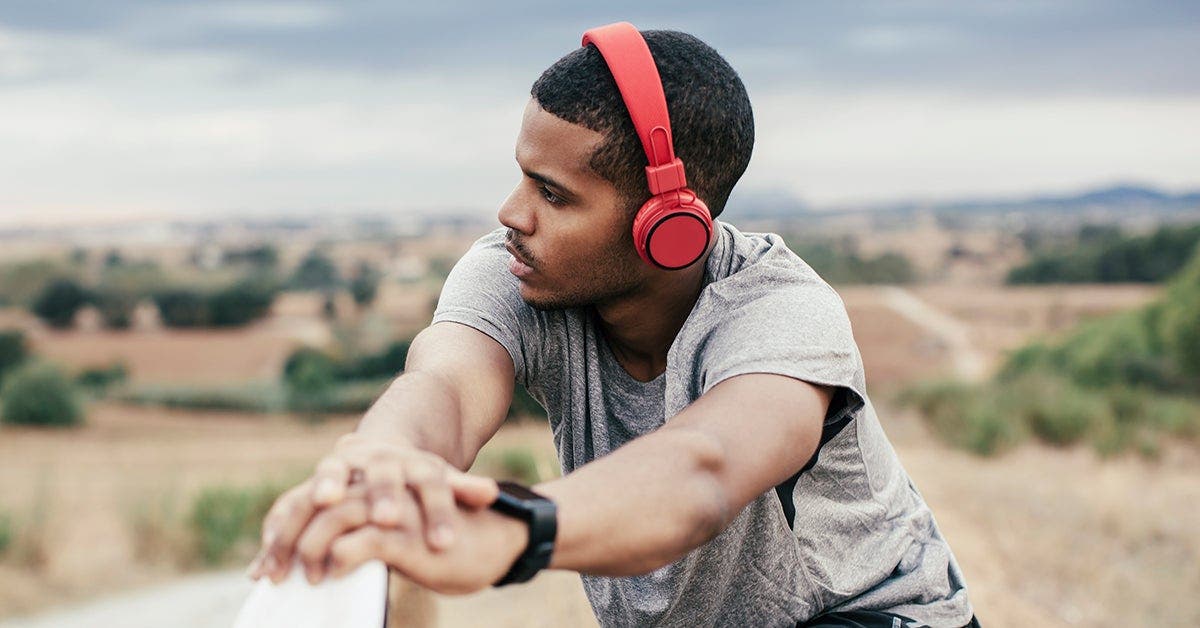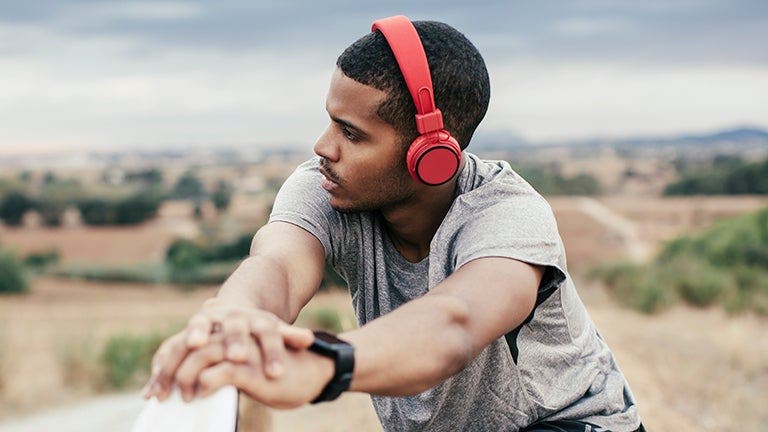Should you work out when your muscles are sore?


In this article:
1/ What is delayed-onset muscle soreness (DOMS)?
2/ The potential benefits of muscle soreness
3/ Should you push yourself when your muscles are sore?
4/ When you shouldn’t work out with muscle soreness
5/ What are the risks of working out with sore muscles?
Whether you’re an exercise novice or elite athlete, working out challenges your muscles — and this is especially true when you make a change in your activity, intensity, or style. Say you’re a runner who tries yoga one day, or you add an extra set to your squat routine. So, it makes sense that your muscles may feel a little achy after the added effort, especially the next day. But there’s a fine line between mild discomfort and pain. Is soreness actually a good thing? And how sore is too sore to workout again?
What is delayed-onset muscle soreness, or DOMS?
The muscle discomfort you feel the next day — or up to 3 days after — a workout is likely delayed-onset muscle soreness, or DOMS.
“Any type of activity that places a new stress or load on a muscle may lead to DOMS,” explains Neal Pire, MA, CSCS, exercise physiologist and certified health coach at Castle Connolly Private Health Partners in New York City. “As its name implies, DOMS is delayed soreness, which is different from any discomfort or pain you may experience during exercise.”
The potential benefits of muscle soreness
When you lift a heavy weight, what you’re really doing is creating micro-tears in your muscle fibers. After doing all that work, those muscles have to repair the tears, and the result of that is bigger, stronger muscles.
“Basically, you’re inflicting damage on your muscle so that it grows,” explains Noam Tamir, CSCS, founder of TS Fitness in New York City. “This process depends on the person, but it normally takes 12 to 48 — and sometimes up to 72 — hours to kick in. The feeling your body experiences during that breakdown-and-repair process can be anything from slight discomfort to ‘I can barely move’ soreness.”
Should you push yourself when your muscles are sore?
Even if your body is still experiencing the after effects of a recent workout, some gentle movement can help you feel better. It can increase blood circulation to the sore muscles and enhance mobility, which in turn will help reduce DOMS, explains Pire.
Tamir also says it’s OK to do exercises that don’t affect the sore muscles. So, if you’re feeling it from yesterday’s upper-body-focused workout, consider doing some lower-body exercises. Walking and stretching are always good, too.
“Make sure you give your body two or three days of rest before repeating the same exercise or training the same specific muscle groups,” says Pire. “You can do other exercises but avoid repeating the same exercises day after day.”
When you should not work out with muscles soreness
Check in with yourself before working out with muscle soreness. “If you are very sore and limited in your range of motion, then I would not advise it,” says Tamir. A rest day is the right choice if you’re experiencing any of the following:
If you have swollen muscles
A little tenderness is fine, but anything more could be a reason to see your doctor — stat. Severe pain and swelling in your arms or legs and dark urine are signs of an exercise-induced condition called rhabdomyolysis, which can cause muscle atrophy and kidney failure if it’s not immediately treated.
If it’s too painful to walk or climb stairs
If you can’t lift your arms or can barely walk down the stairs without your calves cramping, you may want to hold off on going to the gym.
If you’re taking pain medication
If your delayed-onset muscle soreness is so severe that you find yourself reaching for an OTC anti-inflammatory like ibuprofen, it’s best to skip anything hardcore. Something to note: Ibuprofen will ease discomfort, but it won’t speed up the muscle repair process.
What are the potential risks of working out with sore muscles?
Sometimes the promise of the feel-good hormone boost you get from exercise is too much to keep you on the sidelines. But pushing through your typical routine with sore muscles does have potential drawbacks, including (in no particular order):
- Overuse injuries
- Increased muscle pain
- Joint pain
- Decreased exercise performance or output
- Rhabdomyolysis, in extreme cases
What to do to prevent muscle soreness
It’s always a good idea to ease into a new routine, and gradually build up to more challenging workouts, heavier weights, longer distances, and advanced classes. That said, feeling mild soreness or weakness after exercising comes with the territory.
“You can’t really prevent muscle soreness or DOMS,” says certified New York City-based strength and conditioning coach Christi Smith, MS, CSCS. “That’s part of your body’s natural process as it repairs and builds new muscle tissue.”
Still, there are some proactive steps you can take to try to minimize the severity of DOMS and encourage muscle soreness recovery. A few evidence-backed things to try:
Foam rolling
Rolling out muscles before a workout stimulates blood flow and increases mobility, which could decrease the likelihood of developing muscle soreness after working out.
Massage
“Massages and other manual techniques like foam rolling can also help,” says Tamir. Just be mindful of the pressure — it shouldn’t be too much because that can actually create more inflammation in the body and lead to more soreness.
Heat
Studies show soaking in a tub, sitting in a sauna, and heat wraps can help ease post-exercise muscle discomfort and promote recovery.
Cold baths
Sitting in a tub filled with icy water for 10 to 15 minutes (if you can stay in for that long!) can help soothe DOMS symptoms.
Muscle creams
Slathering on a cream or lotion that contains menthol or arnica can help muscles relax and ease discomfort.
Extra sleep
Whether it’s a midday nap or a longer night in bed, the body produces hormones that support muscle and other tissue repair when you rest.
Should you skip a workout with sore muscles?
There’s no shame in taking a rest day. In fact, time off from the gym might be just what your body needs to build and grow new muscle tissue. But if you just can’t stay still, or if you don’t want to lose any of the momentum you’ve created with a new exercise habit, go ahead — just switch things up. Opt for a gentler activity, like walking or restorative yoga, or try moves that engage muscles that aren’t feeling sore.
Related articles
The benefits of pushing through a tough workout
How your body changes when you start working out
--
https://www.acsm.org/docs/default-source/files-for-resource-library/delayed-onset-muscle-soreness-(doms)
If you have swollen muscles: Cleveland Clinic. (2019.) “Rhabdomyolysis.”
https://my.clevelandclinic.org/health/diseases/21184-rhabdomyolysis
If you’re taking pain medication: Journal of Strength and Conditioning Research. (2003.)“The effects of ibuprofen on delayed muscle soreness and muscular performance after eccentric exercise.”
https://pubmed.ncbi.nlm.nih.gov/12580656/
What to do to prevent muscle soreness: International Journal of Environmental Research and Public Health. (2021.) “The Prevalence of Use of Various Post-Exercise Recovery Methods after Training among Elite Endurance Athletes.”
https://pubmed.ncbi.nlm.nih.gov/34770213/
Foam rolling: Frontiers in Physiology. (2019.) “A Meta-Analysis of the Effects of Foam Rolling on Performance and Recovery.”
https://www.ncbi.nlm.nih.gov/pmc/articles/PMC6465761/
Massages: Frontiers in Physiology. (2017.) “Massage Alleviates Delayed Onset Muscle Soreness after Strenuous Exercise: A Systematic Review and Meta-Analysis.”
https://www.frontiersin.org/articles/10.3389/fphys.2017.00747/full
Heat: European Journal of Applied Physiology. (2008.) “Effect of Hydrotherapy on the Signs and Symptoms of Delayed Onset Muscle Soreness.”
https://link.springer.com/article/10.1007/s00421-007-0605-6
Official Journal of the Canadian Academy of Sport Medicine. (2017.) “The Efficacy of Sustained Heat Treatment on Delayed-Onset Muscle Soreness.”
https://pubmed.ncbi.nlm.nih.gov/27454218/
Cold baths: Sports Medicine (Auckland, N.Z.). (2016.) “Can Water Temperature and Immersion Time Influence the Effect of Cold Water Immersion on Muscle Soreness? A Systematic Review and Meta-Analysis.”
https://www.ncbi.nlm.nih.gov/pmc/articles/PMC4802003/
Muscle creams: Medicine and Science in Sports and Exercise. (2019.) “Delayed-Onset Muscle Soreness and Topical Analgesic Alter Corticospinal Excitability of the Biceps Brachii.”
https://pubmed.ncbi.nlm.nih.gov/31157708/
European Journal of Sport Science. (2014.) “The effects of topical Arnica on performance, pain and muscle damage after intense eccentric exercise.”
https://www.tandfonline.com/doi/abs/10.1080/17461391.2013.829126
Extra sleep: Medical Hypotheses. (2011.) “Sleep and muscle recovery: endocrinological and molecular basis for a new and promising hypothesis.”
https://pubmed.ncbi.nlm.nih.gov/21550729/
